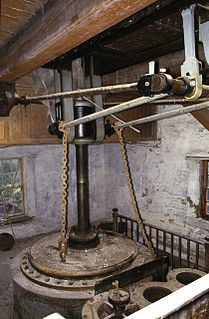A steam brake is a type of brake for steam locomotives and their tenders, whereby a steam cylinder works directly on the brake linkages.
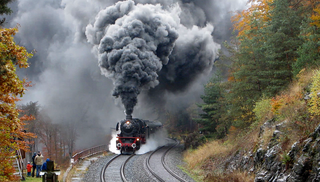
A steam locomotive is a type of railway locomotive that produces its pulling power through a steam engine. These locomotives are fueled by burning combustible material – usually coal, wood, or oil – to produce steam in a boiler. The steam moves reciprocating pistons which are mechanically connected to the locomotive's main wheels (drivers). Both fuel and water supplies are carried with the locomotive, either on the locomotive itself or in wagons (tenders) pulled behind.

A tender or coal-car is a special rail vehicle hauled by a steam locomotive containing its fuel and water. Steam locomotives consume large quantities of water compared to the quantity of fuel, so their tenders are necessary to keep them running over long distances. A locomotive that pulls a tender is called a tender locomotive. Locomotives that do not have tenders and carry all their fuel and water on board the locomotive (itself) instead are called tank locomotives.

The cylinder is the power-producing element of the steam engine powering a steam locomotive. The cylinder is made pressure-tight with end covers and a piston; a valve distributes the steam to the ends of the cylinder. Cylinders were cast in cast iron and later in steel. The cylinder casting includes other features such as valve ports and mounting feet. The last big American locomotives incorporated the cylinders as part of huge one-piece steel castings that were the main frame of the locomotive. Renewable wearing surfaces were needed inside the cylinders and provided by cast-iron bushings.
Steam brakes were primarily used on railways where vacuum brakes were used to brake the train, but where there was no vacuum brake on the steam locomotive itself, as for example in the United Kingdom, or where there was only a cable-operated brake (e.g. a Heberlein brake) running along the train, like for example in Saxony on the narrow gauge railways.

The United Kingdom, officially the United Kingdom of Great Britain and Northern Ireland but more commonly known as the UK or Britain, is a sovereign country lying off the north-western coast of the European mainland. The United Kingdom includes the island of Great Britain, the north-eastern part of the island of Ireland and many smaller islands. Northern Ireland is the only part of the United Kingdom that shares a land border with another sovereign state—the Republic of Ireland. Apart from this land border, the United Kingdom is surrounded by the Atlantic Ocean, with the North Sea to the east, the English Channel to the south and the Celtic Sea to the south-west, giving it the 12th-longest coastline in the world. The Irish Sea lies between Great Britain and Ireland. With an area of 242,500 square kilometres (93,600 sq mi), the United Kingdom is the 78th-largest sovereign state in the world. It is also the 22nd-most populous country, with an estimated 66.0 million inhabitants in 2017.

Heberlein brake is a continuous railway brake used in Germany that is applied by means of a mechanical cable. Train braking is therefore initiated centrally from the locomotive using a winder. This causes the brake clips to be applied on individual wagons, assisted by a servo system which makes use of the rotation of the axle. The brakes operate automatically if the cable snaps. A typical feature of Heberlein brakes is the clearly visible cable run on top of the wagons, but cables can also be led underneath the wagons, as on the Spreewaldbahn railway line. Heberlein brakes were eventually largely replaced by compressed-air brakes or, sometimes, by vacuum brakes on narrow gauge railway vehicles.

The Kingdom of Saxony, lasting between 1806 and 1918, was an independent member of a number of historical confederacies in Napoleonic through post-Napoleonic Germany. The kingdom was formed from the Electorate of Saxony. From 1871 it was part of the German Empire. It became a Free state in the era of Weimar Republic in 1918 after the end of World War I and the abdication of King Frederick Augustus III of Saxony. Its capital was the city of Dresden, and its modern successor state is the Free State of Saxony.
Steam brakes are usually found today on heritage steam locomotives.

A steam engine is a heat engine that performs mechanical work using steam as its working fluid. The steam engine uses the force produced by steam pressure to push a piston back and forth inside a cylinder. This pushing force is transformed, by a connecting rod and flywheel, into rotational force for work. The term "steam engine" is generally applied only to reciprocating engines as just described, not to the steam turbine.
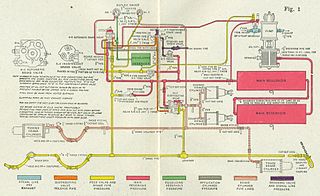
A railway air brake is a railway brake power braking system with compressed air as the operating medium. Modern trains rely upon a fail-safe air brake system that is based upon a design patented by George Westinghouse on March 5, 1868. The Westinghouse Air Brake Company was subsequently organized to manufacture and sell Westinghouse's invention. In various forms, it has been nearly universally adopted.
The vacuum brake is a braking system employed on trains and introduced in the mid-1860s. A variant, the automatic vacuum brake system, became almost universal in British train equipment and in countries influenced by British practice. Vacuum brakes also enjoyed a brief period of adoption in the United States, primarily on narrow-gauge railroads. Its limitations caused it to be progressively superseded by compressed air systems starting in the United Kingdom from the 1970s onward. The vacuum brake system is now obsolete; it is not in large-scale usage anywhere in the world, other than in South Africa, largely supplanted by air brakes.

The valve gear of a steam engine is the mechanism that operates the inlet and exhaust valves to admit steam into the cylinder and allow exhaust steam to escape, respectively, at the correct points in the cycle. It can also serve as a reversing gear. It is sometimes referred to as the "motion".

An atmospheric railway uses differential air pressure to provide power for propulsion of a railway vehicle. A static power source can transmit motive power to the vehicle in this way, avoiding the necessity of carrying mobile power generating equipment. The air pressure, or partial vacuum can be conveyed to the vehicle in a continuous pipe, where the vehicle carries a piston running in the tube. Some form of re-sealable slot is required to enable the piston to be attached to the vehicle. Alternatively the entire vehicle may act as the piston in a large tube.

This is a glossary of the components found on typical steam locomotives.

A railway brake is a type of brake used on the cars of railway trains to enable deceleration, control acceleration (downhill) or to keep them immobile when parked. While the basic principle is familiar from road vehicle usage, operational features are more complex because of the need to control multiple linked carriages and to be effective on vehicles left without a prime mover. Clasp brakes are one type of brakes historically used on trains.

The Walschaerts valve gear is a type of valve gear invented by Belgian railway mechanical engineer Egide Walschaerts in 1844 used to regulate the flow of steam to the pistons in steam engines. The gear is sometimes named without the final "s", since it was incorrectly patented under that name. It was extensively used in steam locomotives from the late 19th century until the end of the steam era.

An automatic lubricator, is a device fitted to a steam engine to supply lubricating oil to the cylinders and, sometimes, the bearings and axle box mountings as well. There are various types of automatic lubricator, which include various designs of displacement, hydrostatic and mechanical lubricators.
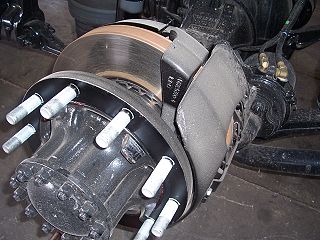
An air brake or, more formally, a compressed air brake system, is a type of friction brake for vehicles in which compressed air pressing on a piston is used to apply the pressure to the brake pad needed to stop the vehicle. Air brakes are used in large heavy vehicles, particularly those having multiple trailers which must be linked into the brake system, such as trucks, buses, trailers, and semi-trailers, in addition to their use in railroad trains. George Westinghouse first developed air brakes for use in railway service. He patented a safer air brake on March 5, 1872. Westinghouse made numerous alterations to improve his air pressured brake invention, which led to various forms of the automatic brake. In the early 20th century, after its advantages were proven in railway use, it was adopted by manufacturers of trucks and heavy road vehicles.

A snifting valve is an automatic anti-vacuum valve used in a steam locomotive when coasting. The word Snift imitates the sound made by the valve.

An expansion valve is a device in steam engine valve gear that improves engine efficiency. It operates by closing off the supply of steam early, before the piston has travelled through its full stroke. This cut-off allows the steam to then expand within the cylinder. This expanding steam is still sufficient to drive the piston, even though its pressure decreases as it expands. As less steam is supplied in the shorter time for which the valve is open, use of the expansion valve reduces the steam consumed and thus the fuel required. The engine may deliver two-thirds of the work, for only one-third of the steam.
A countersteam brake is a brake on a steam locomotive that uses the engine to help brake the locomotive.

The Vauclain compound was a type of compound steam locomotive that was briefly popular around 1900. Developed at the Baldwin Locomotive Works, it featured two pistons moving in parallel, driving a common crosshead and controlled by a common valve gear using a single, complex piston valve.

A vacuum engine derives its force from air pressure against one side of the piston, which has a partial vacuum on the other side of it. At the beginning of an outstroke, a valve in the head of the cylinder opens and admits a charge of burning gas and air, which is trapped by the closing of the valve and expands. Towards the end of the stroke the charge comes into contact with a water- or air-cooled part of the cylinder and is chilled, causing a sudden drop in pressure sufficient to suck the piston – which is open towards the crank – back on the return stroke. The valve opens again in time for the piston to expel the burnt gases before the next outstroke begins.
On a steam locomotive, the reversing gear is used to control the direction of travel of the locomotive. It also adjusts the cutoff of the steam locomotive.
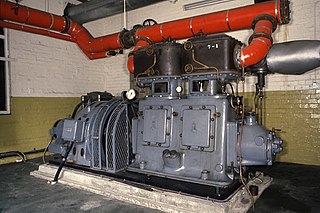
High-speed steam engines were one of the final developments of the stationary steam engine. They ran at a high speed, of several hundred rpm, which was needed by tasks such as electricity generation.

The Central South African Railways Rack 4-6-4RT of 1905 was a South African steam locomotive from the pre-Union era in Transvaal Colony.
Locomotive 51 of the Limburgsche Tramweg Maatschappij was a Garratt locomotive. It was the only Garratt type locomotive in the Netherlands. It was built by Henschel with builder number 22063 in 1931. It entered service in the same year. Ir. D. Verhoop, in collaboration with Hanomag, is the likely designer of the locomotive. Builder number 10758 was reserved by Hanomag. The locomotive was completed after the take-over of Hanomag by Henschel.







